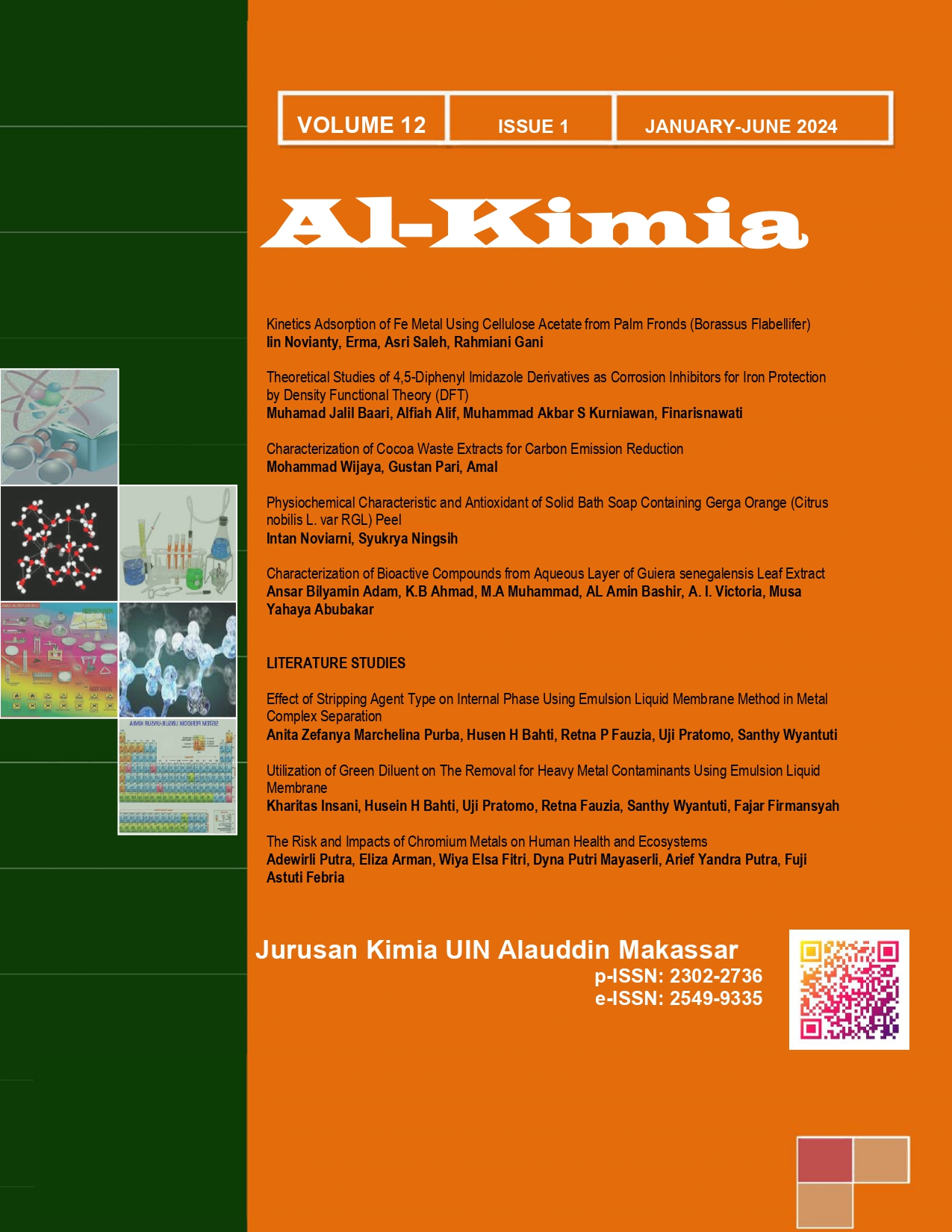Characteristic and Chemical Compound of charcoal Cocoa Wasted by Pyrolysis Process
Abstrak
Indonesia continues to experience a decline in cocoa production due to the aging of cocoa plants, conversion of cocoa plantations, pests, and diseases, as well as the government's focus on food crops. These factors contribute to the problem of decreasing cocoa yields. The objectives of this research are to develop the production of cacao tea from cocoa leaves as a natural herbal drink, and to identify bioactive chemical compounds resulting from the pyrolysis of cocoa waste by controlling temperature and time. The methodology employed in this study includes the analysis of lignin, cellulose, and hemicellulose content in cocoa leaves. The pyrolysis process was conducted at 300°C, 400°C, and 500°C. Extraction was performed using an extractor, where the cocoa leaf waste was mixed with water heated to 80°C for 3 hours. The analysis of flavonoid and antioxidant levels in Pinrang cocoa leaves revealed lignin levels of 43.13%, holocellulose content of 47.11%, alpha-cellulose content of 31.13%, and cellulose content of 43.13%. Proximate analysis of Kolaka Regency cocoa leaves indicated phenol levels of 529.52 mg/kg, catechin levels of 615.71 mg/kg, glucose content of 6.68%, caffeine content of 329.56 mg/kg, carbon content of 52.20%, nitrogen content of 1.24%, hydrogen content of 17.55%, and oxygen content of 29.01%. For cocoa leaf extract from Pinrang Regency, the total flavonoids were 6.01% w/w, while for Kolaka Regency, the total flavonoids were 35.10% w/w. The utilization of cocoa leaves from Kolaka Regency demonstrated superior antioxidant content compared to those from Pinrang Regency. This indicates that cacao tea products made from Kolaka Regency cocoa leaves have great potential for development as a herbal drink. However, there has been limited research on this topic, particularly regarding the use of cocoa waste for cacao tea products.
##plugins.generic.usageStats.downloads##
Referensi
Daud Z, Mohd Kassim AS, Mohd Aripin A, Awang H, Mohd Hatta MZ. 2013. Chemical Composition and Morphological of Cocoa Pod Husks and Cassava Peels for Pulp and Paper Production . Australian Journal of Basic and Applied Sciences, 7(9), 406-411
Dziadek, K., Kopeć, A., and Tabaszewska, M. 2018 Potential of sweet cherry (Prunus avium L.) by-products bioactive compounds and antioxidant activity of leaves and petioles,” European Food Research and Technology 245(3), 763-772. DOI:10.1007/s00217-018-3198-
Omulo G1, Willett S2, Seay,J 2, Banadda N1, Kabenge ,I1, Zziwa ,A1 & Kiggund, N1 2017.Characterization of Slow Pyrolysis Wood Vinegar and Tar from Banana Wastes Biomass as Potential Organic Pesticides Journal of Sustainable Development; Vol. 10, No. 3; ISSN 1913-9063 E-ISSN 1913-9071
Ouattara, L.Y.; Kouassi, E.K.A.; Soro, D.; Soro, Y.; Yao, K.B.; Adouby, K.; Drogui, A.P.; Tyagi, D.R.; Aina, P.M. 2020. Cocoa pod husks as potential sources of renewable high-value-added products: A review of current valorizations and future prospects. BioResources 2021, 16,. [CrossRef]
Shao.L, You T, Wang C, Yang G, Xu F, and Lucia L. 2017. Catalytic Stepwise Pyrolysis of Technical Lignin. J.Bioresources. 12(3), 4639-4651.
Temiz, A., Akbas, S., Panov, D., Terziev, N., Alma, M. H. 2013. Chemical composition and efficiency of bio-oil obtained from giant cane (Arundo donax L.) as a wood preservative. BioResources, ( 8(2), 2084–2098. DOI 10.15376/biores.8.2.2084-2098.
Vásquez, Z.S.; de Carvalho Neto, D.P.; Pereira, G.V.M.; Vandenberghe, L.P.S.; de Oliveira, P.Z.; Tiburcio, P.B.; Rogez, H.L.G.; Góes Neto, A.; Soccol, C.R. 2019, Biotechnological approaches for cocoa waste management: A review. Waste Manag. 90, 72–83. [CrossRef] [PubMed]
Wijaya, M., Wiharto, M Danial.2019. Using pine and cocoa waste with pyrolysis technology by liquid smoke, charcoal and bio char Journal of Physics: Conference Series..1321 (2), 022031
Wijaya.M, Wiharto.,M.dan Anwar.M.. 2020 Proses Pembuatan Fenol dari asap cair kulit buah kakao (theobroma cacao) sebagai Anti septic IDP000066432. www.dgip.goid,
Authors who publish with this journal agree to the following terms:
1) Authors retain copyright and grant the journal right of first publication with the work simultaneously licensed under a Creative Commons Attribution License that allows others to share the work with an acknowledgement of the work's authorship and initial publication in this journal.
2) Authors are able to enter into separate, additional contractual arrangements for the non-exclusive distribution of the journal's published version of the work (e.g., post it to an institutional repository or publish it in a book), with an acknowledgement of its initial publication in this journal.
3)Authors are permitted and encouraged to post their work online (e.g., in institutional repositories or on their website) prior to and during the submission process, as it can lead to productive exchanges, as well as earlier and greater citation of published work (See The Effect of Open Access).


